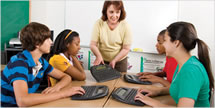
Arkansas’ Osceola School District has students use Renaissance Learning’s NEO—a low-cost, battery-powered keyboard with word processing and quizzing capabilities—for their writing projects and Wii gaming systems for physical education. The district provides teachers with paid training for any technology that is implemented and follows up with training throughout the year. Thanks to the use of these and other resources, participation in phys-ed classes has increased—and students are more engaged in and connected to school activities.
For these reasons and more, we’ve chosen Osceola School District as our “eSchool of the Month” for September. Here, Instructional Technology Director Shantele Raper discusses the district’s ed-tech accomplishments and the keys to its success.
(Editor’s note: To nominate your school or district for our “eSchool of the Month” feature, and to read about past winners, go to http://www.eschoolnews.com/eschool-of-the-month.)
How do you use technology to advance student learning?
The Osceola School District is dedicated to placing technology in the hands of students and teachers. Technology can be found in every classroom with SMART Boards, NEOs, iPods, student computers, laptop carts, Wii entertainment systems, and a variety of applications to promote student achievement.
Kindergarten through eighth-grade students visit computer labs to work in SkillsTutor and Classworks. The lessons are aligned by the core teachers to reinforce the learning objectives taking place in the classroom, or as our Response to Intervention (RtI) activities. Kindergarten students have begun taking the Northwest Education Association’s Measures of Academic Progress (MAP) computer-adaptive test this year, which gives us data to help teachers create lessons that target students’ individual needs. First through 12th-grade students have access to Renaissance Learning NEOs, where they can work on MathFacts in a Flash, Accelerated Reading, Accelerated Math, KeyWords, and collaborative writing.
Have you noticed an increase in student performance and/or motivation as a result of this technology use? If so, how?
As digital learners, our students are always motivated by the use of technology. We always see an increase in student participation with the use of technology. For example, we see an increase in writing content when students use NEOs for their writing samples. Another example is the amount of participation in physical education with the use of Wiis. Students who would rather get a zero than participate are actually up and moving with the Wii systems. Of course, students are always engaged with the use of iPods. Using apps and flashcards that correlate with textbooks makes an exciting connection for students.
How do you use technology to streamline school administration and aid in decision-making? To what effect?
The most common tool used in decision making is usage reports from all of our technology resources. We are able to see what teachers are using, how much time students are spending using the resources, and, in many cases, the actual student performance data. This process has given our teachers an enormous amount of student data that can help them see the bigger picture. The most recent addition to our technology resources is Teachscape, which is a teacher observation resource that allows administrators to make better-informed decisions about professional development needs.
How have you financed your ed-tech initiatives?
The biggest challenge for school districts is finding the financial resources to maintain a high-quality technology program. We utilize the e-Rate as much as possible and fill the gaps with aggressive grant writing, local funds, and donations from local businesses and industry.
What ed-tech project are you most proud of, and why?
Our Wii entertainment system project is a simple, but effective, project that has continued to engage students in physical education, scenario-based projects, and academic games. With the use of the Wiis, we get 100-percent student engagement while allowing students to enjoy their learning experience.
What have been your biggest ed-tech challenges, and why? How have you overcome them?
The biggest challenge has been finding the time to train teachers and reinforce what they have learned with reliable support. We have overcome these challenges by providing our teachers with paid training for any technology that is implemented and have made every attempt to follow up with training throughout the year. The technology staff has grown to provide quicker response times to any technological issues. We also implemented an online technology support system that is working very well.
What’s your best ed-tech advice for colleagues?
Provide high-quality professional development and follow-up, get and provide feedback, and reevaluate often.
- Arizona’s Apache Junction Unified School District Supports Innovative Teaching and Learning with New EdTech Resources - April 19, 2024
- AI Educational Partnership to Elevate Classroom Presentations, Assessments - April 18, 2024
- SME Education Foundation Expands Manufacturing and Engineering Opportunities to 15K Additional Michigan Students - April 18, 2024

